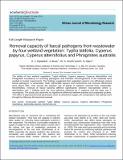| dc.contributor.author | Kipasika, H. J | |
| dc.contributor.author | Buza, Joram | |
| dc.contributor.author | Smith, W. A | |
| dc.contributor.author | Njau, Karoli | |
| dc.date.accessioned | 2019-05-24T08:53:37Z | |
| dc.date.available | 2019-05-24T08:53:37Z | |
| dc.date.issued | 2016-05-21 | |
| dc.identifier.issn | 1996-0808 | |
| dc.identifier.uri | https://doi.org/10.5897/AJMR2016.7931 | |
| dc.identifier.uri | http://dspace.nm-aist.ac.tz/handle/123456789/198 | |
| dc.description | Research Article published by African Journal of Microbiology Research Vol.56 (19) | en_US |
| dc.description.abstract | The ability of four wetland vegetation: Typha latifolia, Cyperus papyrus, Cyperus alternifolius and Phragmites mauritianus in removing pathogenic and indicator microorganisms in the wetlands were studied in bucket experiments. The findings suggested that vegetated systems can effectively reduce faecal pathogens in wastewater. Both Salmonella species and Escherichia coli removal efficiencies were above 98%. This proved the positive use of plants in bacteria removal from wastewater. Nevertheless, removal of faecal bacteria differed significantly between macrophytes where C. alternifolius and T. latifolia were the most effective followed by C. papyrus and the least was P. mauritianus. The study also observed no significant difference between planted and unplanted buckets. The effect of physicochemical parameters such as dissolved oxygen, pH, temperature and salinity were thought to influence the bacterial remova | en_US |
| dc.language.iso | en_US | en_US |
| dc.publisher | African Journal of Microbiology Research | en_US |
| dc.subject | Constructed wetland | en_US |
| dc.subject | Typha latifolia | en_US |
| dc.subject | Cyperus alternifolius | en_US |
| dc.title | Removal capacity of faecal pathogens from wastewater by four wetland vegetation: Typha latifolia, Cyperus papyrus, Cyperus alternifolius and Phragmites australis | en_US |

